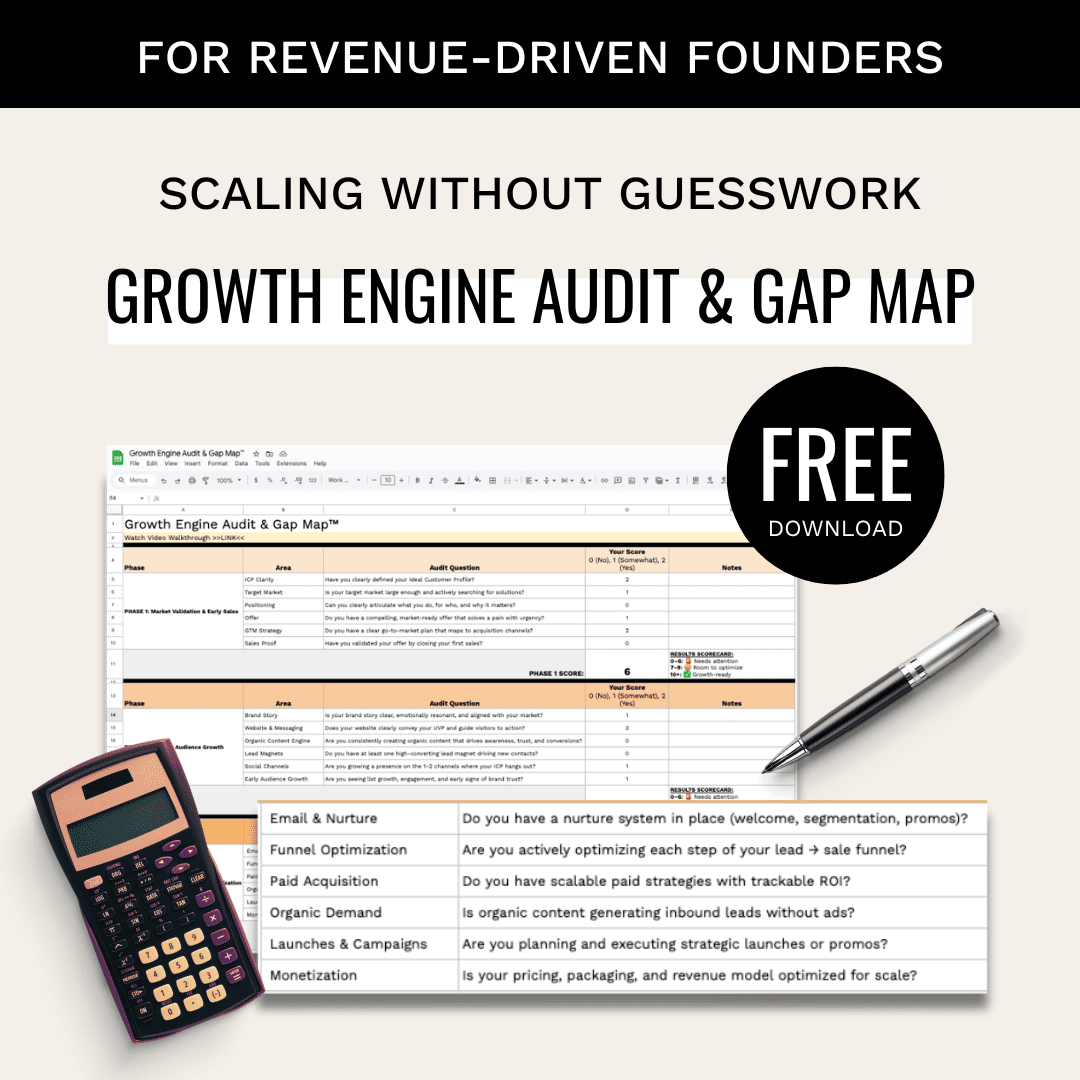Testing your value proposition ensures your product or service resonates with customers and delivers results. Here’s how to do it effectively:
- Define Your Audience: Identify your ideal customer profile (ICP) and segment them by traits like demographics, challenges, and industry.
- Create Hypotheses: Write clear, testable statements linking customer problems to your solution and prioritize them by importance.
- Run Tests: Use methods like landing pages, mockups, and customer feedback to validate your ideas.
- Review Results: Analyze metrics like conversions and feedback to uncover patterns and insights.
- Refine and Repeat: Adjust your value proposition based on findings and establish a routine for continuous testing.
Quick Overview
| Step | Key Action | Outcome |
|---|---|---|
| Define Audience | Build ICPs and segment customers | Clear target groups for testing |
| Create Hypotheses | Write and prioritize testable statements | Focused testing with measurable goals |
| Run Tests | Use landing pages, mockups, and feedback | Validate ideas with real customer input |
| Review Results | Analyze data and patterns | Identify what’s working and what’s not |
| Refine and Repeat | Adjust and retest regularly | Keep messaging aligned with customer needs |
Testing your value proposition is an ongoing process that drives smarter decisions and better results. Start small, measure what matters, and keep refining!
How to Test Value Propositions like a Business Designer
Step 1: Define Your Target Audience
To make your testing efforts effective, start by identifying the audience most likely to benefit from what you’re offering.
Build Ideal Customer Profiles (ICPs)
An Ideal Customer Profile (ICP) outlines the characteristics of your perfect customer. To create one, focus on these three dimensions:
Demographics & Firmographics:
- Company size and revenue
- Industry type
- Geographic location
- Technology stack in use
- Budget authority
- Decision-making structure
Psychographics:
- Business goals and objectives
- Pain points or challenges
- Key success metrics
- Level of risk tolerance
- Stage of innovation adoption
Break Down Audiences into Segments
Once you’ve defined your ICPs, divide them into smaller, more specific groups based on shared traits. This segmentation allows for precise testing and tailored strategies.
| Segment Type | Key Criteria | Testing Focus |
|---|---|---|
| Growth Stage | Early-stage, Growth-stage, Enterprise | Understanding scalability and resource needs |
| Use Case | Main pain point, Job-to-be-done | Evaluating solution fit and feature priorities |
| Industry | Market vertical, Regulatory needs | Ensuring compliance and market-specific value |
To start, focus on a few core segments, set clear boundaries for each, and validate your assumptions using customer feedback.
For tech companies, refining your audience early is especially important – it helps secure those crucial first customers and build momentum.
With your audience clearly defined and segmented, you’re ready to dive into Step 2: developing precise hypotheses about customer needs.
Step 2: Create Customer Need Hypotheses
This step is about crafting testable hypotheses that align customer needs with your value proposition.
Write Clear Hypotheses
Your hypothesis should directly link a specific customer problem to a proposed solution. A good structure to follow is:
"We believe that [customer segment] experiences [specific problem] when trying to [job to be done]. Our [solution] will [solve problem] by [mechanism], resulting in [measurable benefit]."
For example, instead of saying, "Customers will like our AI dashboard", write something more precise, like:
"We believe that marketing managers in SaaS companies experience difficulty analyzing campaign performance across multiple channels. Our unified analytics platform will reduce reporting time by 50% through automated data consolidation, resulting in faster decision-making and improved campaign optimization."
This approach ensures your hypothesis includes all critical elements: customer segment, problem, solution, expected outcome, and measurable value. Once you’ve written your hypotheses, prioritize them based on their potential impact and feasibility.
Rank Your Assumptions
To prioritize effectively, use a matrix like the one below:
| Priority Level | Importance | Uncertainty | Testing Approach |
|---|---|---|---|
| Critical | High | High | Test immediately with direct customer feedback |
| Important | High | Low | Validate through existing data and quick tests |
| Secondary | Low | High | Test after critical hypotheses |
| Minor | Low | Low | Document but defer testing |
This framework helps you identify which hypotheses to test first, considering factors like customer impact, risk to the business, and the resources required for testing.
A practical example of prioritization involves using card sorting to evaluate benefit statements. For instance, a tech company working on a health product created simple statements such as, "A product that shows me ____ about my body when I use it." They then asked target users to rank these statements. This activity quickly highlighted which value propositions resonated most with their audience.
Common Mistakes to Avoid
When writing hypotheses, steer clear of these pitfalls:
- Writing vague or untestable statements
- Focusing on features instead of benefits
- Combining multiple assumptions into one hypothesis
- Overlooking price sensitivity
- Using internal jargon that customers may not understand
Make sure to balance functional benefits with emotional drivers to fully capture what appeals to your audience.
Once you’ve defined and prioritized your hypotheses, you’re ready to move on to testing them in Step 3.
Step 3: Run Simple Tests
Put your ideas to the test using straightforward and budget-friendly methods.
Test with Landing Pages
Landing pages are a great way to test how well your value propositions resonate. By creating focused, single-purpose pages, you can gauge how potential customers react to specific claims.
- Build multiple versions of landing pages, each highlighting a different value proposition.
- Drive targeted traffic to these pages using ads or social media.
- Measure key metrics like:
- Click-through rates (CTR)
- Time spent on the page
- Conversion actions (e.g., sign-ups, downloads)
- Bounce rates
Keep each landing page focused on one value proposition to ensure clarity and accurate results.
Test with Mockups
If your landing page tests show promise, take it a step further with mockups. These visual prototypes help you test interest in potential features or solutions without the need for full development. This technique, often called "fake door testing", gives users a sneak peek of your offering.
How to run effective mockup tests:
- Use tools like Figma or Adobe XD to create high-quality prototypes.
- Share different versions with specific audience segments.
- Include clear calls to action to measure interest.
- Monitor engagement to assess which features or designs resonate most.
Keep the focus on the core value of your product rather than overwhelming users with full product details.
Collect Direct Feedback
While quantitative data is invaluable, combining it with qualitative feedback gives you a fuller picture.
| Method | Best For | Sample Size | Key Metrics |
|---|---|---|---|
| Customer Interviews | Deep insights | 5-10 per segment | Problem validation, willingness to pay |
| Online Surveys | Broad audience validation | 100+ responses | Feature prioritization, pricing sensitivity |
| User Testing | Usability and experience check | 3-5 per round | Task completion, user satisfaction |
When gathering feedback, focus on understanding:
- How severe the problem is for your audience
- What solutions they currently rely on
- How sensitive they are to pricing and what factors influence their buying decisions
- Any potential obstacles that might prevent them from adopting your solution
Pro tip: Take note of exact customer quotes during interviews or surveys. These unfiltered insights often highlight details that summarized feedback can miss.
sbb-itb-e8c8399
Step 4: Review Test Results
Carefully reviewing your test results is crucial for uncovering meaningful insights that can guide the refinement of your value proposition.
Measure Success Metrics
To evaluate how well your value propositions perform, focus on measurable metrics:
- Conversion Metrics: Look at sign-up rates, demo requests, or other actions that indicate user interest.
- Engagement Metrics: Track behaviors like time spent on a page or how far users scroll.
- Customer Feedback: Pay attention to satisfaction ratings, survey responses, and direct feedback.
Compare these metrics against your benchmarks to assess performance. Make sure your sample sizes are large enough to provide reliable results. Take note of both what’s working well and where there’s room for improvement.
Using a metrics-driven approach ensures your decisions are based on solid data, helping you stay focused on what matters most to your audience.
Find Data Patterns
Look for patterns in the data to uncover trends and insights by:
- Comparing how different audience segments respond.
- Examining correlations between metrics to identify early indicators of success.
- Using dashboards or visual tools to track trends and communicate findings clearly.
Spotting these patterns will help you understand what’s driving results and where adjustments might be needed.
Step 5: Update Your Value Proposition
After analyzing your test results, it’s time to decide how to fine-tune your value proposition.
Decide Whether to Adjust or Maintain
When evaluating your test outcomes, focus on these key areas:
- Statistical Significance: Make sure you’ve collected enough data to confidently back your decisions.
- Performance Metrics: Compare your results to your initial goals and benchmarks to measure success.
- Customer Feedback: Look for recurring themes in feedback that highlight areas needing improvement.
Based on your findings, you have a few options:
- Minor Tweaks: Make small adjustments to specific parts of your messaging while keeping the core idea intact.
- Moderate Updates: Reframe the way you communicate your main benefits to better align with customer needs.
- Complete Overhaul: If your data shows a major disconnect, consider reworking your value proposition entirely.
Once you’ve made your changes, it’s crucial to establish a system for ongoing evaluation.
Build a Routine for Regular Testing
To keep your value proposition relevant, you’ll need to test it regularly and adapt to market changes.
Here’s what an effective testing system should include:
- Continuous Monitoring: Use analytics tools to track performance metrics in real-time.
- Consistent Feedback Loops: Gather insights through surveys, interviews, or other customer feedback channels.
- Clear Review Triggers: Identify events – like shifts in the market, new product launches, or changes in customer behavior – that signal it’s time for a review.
Conclusion: Next Steps
Testing value propositions isn’t just a one-time task – it’s an ongoing process that lays the groundwork for smarter, data-driven decisions. By following the outlined five steps, you can refine your messaging and enhance the way customers perceive your value.
Start Small with Simple Tests
Kick things off with straightforward tests, like card sorting, to validate your assumptions without over-investing resources. For example, TheraSpecs ran three different value propositions on their homepage. This simple experiment led to better user understanding and increased engagement.
Build a Testing Framework
Create a structured approach to testing by scheduling regular evaluations, tracking essential metrics (like conversion rates or customer acquisition costs), and setting up feedback systems across your teams. This ensures that improvement becomes a consistent part of your strategy.
Measure What Matters
Focus on metrics that align with your business goals. Here are a few key areas to monitor:
| Metric Type | What to Measure |
|---|---|
| Customer Response | Net Promoter Score (NPS), satisfaction ratings |
| Financial Impact | Customer Lifetime Value (CLV), acquisition costs |
| Market Performance | Conversion rates, revenue growth |
| Product Adoption | Usage patterns, retention rates |
These metrics help you see the bigger picture while also pinpointing areas for improvement.
Keep Insights Accessible and Actionable
To make the most of your testing efforts, document your findings in a centralized knowledge base. Share these insights across teams and host regular workshops to ensure everyone understands and applies the value proposition effectively. This collaborative approach keeps your messaging aligned and impactful as market conditions evolve.
FAQs
How do I decide which customer needs to test first when validating value propositions?
To prioritize customer needs effectively when testing, concentrate on hypotheses that align closely with your business objectives and promise the greatest impact. Begin by pinpointing the needs that matter most to your target audience – those that directly shape their decisions. Next, evaluate how practical it is to test these ideas, considering your resources, time constraints, and the data at hand. Focusing on hypotheses that offer significant insights with minimal effort can provide quick wins and help you fine-tune your value propositions more effectively.
What mistakes should I avoid when writing testable hypotheses for value propositions?
To craft hypotheses for value propositions that truly deliver results, steer clear of these common missteps:
- Being too vague: A good hypothesis is clear and measurable. Avoid general statements that lack precise metrics or criteria for success.
- Overlooking your audience: Your hypothesis should reflect the needs, behaviors, and preferences of your target audience. Misaligned assumptions can lead to misleading outcomes.
- Testing too many variables at once: Stick to one variable at a time. Trying to evaluate multiple factors together can muddy the waters, making it hard to pinpoint what actually works.
By sidestepping these errors, you’ll be better equipped to create hypotheses that lead to actionable insights and help fine-tune your value propositions.
How can I keep my value proposition testing relevant and effective over time?
To keep your value proposition testing on point, it’s important to embrace a mindset of constant refinement. Start by revisiting your target audience regularly – after all, their needs and preferences can shift over time. Adjust your hypotheses and testing methods to stay in sync with changes in market trends, customer behavior, or advancements in technology.
Make it a habit to gather feedback through tools like surveys, interviews, or analytics. Use this information to fine-tune your value proposition. Don’t shy away from trying out fresh ideas or approaches to meet your audience’s evolving expectations. This ongoing process ensures your value proposition stays relevant and impactful.
Related Blog Posts
- A/B Testing Steps for Landing Pages
- 5 Lean Experiments You Can Run This Week to Validate Product Market Fit
- How to Test a New Product Idea by Use Landing Pages and $100 in Ads
- Build Less, Learn More: A Framework for Structured Market Validation




